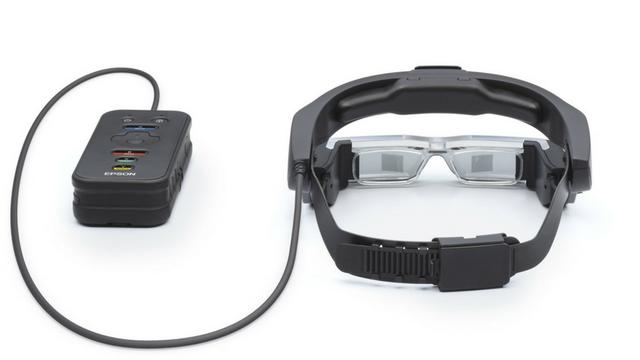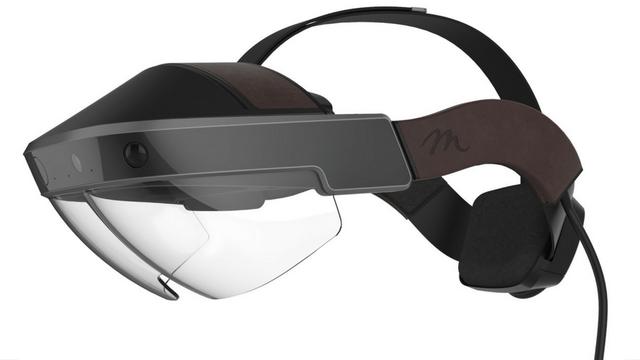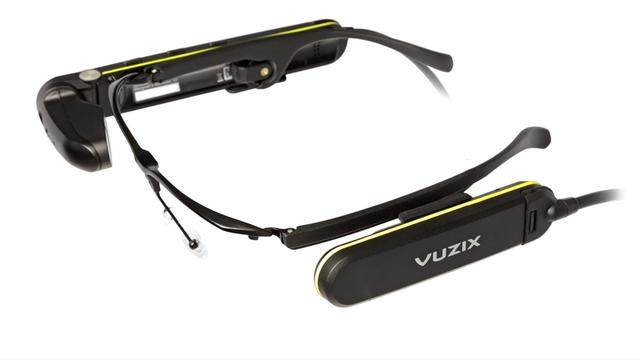Although Google Glass has suffered a temporary failure due to privacy and design issues, this will not hinder the trend of wearable head-mounted display devices destined to be accepted by the entire society. Technology is the primary productivity, after all. However, there are still many head-mounted display devices that play a very important role in all walks of life.

Perhaps wearing a display device does not have much effect on the average person, but in some public places or commercial situations, these devices can bring great convenience through a certain degree of augmented reality technology.
"Wearable devices will make our work more efficient. They will immediately show the wearer the information most needed today, such as displaying the patient's historical medical records or data through the display screen," said Stephanie Lawrence, an analyst at ABI Research. Shipments of global wearable devices will increase from 202 million in 2016 to 500 million in 2021. These devices will enable employees to work more efficiently and save companies a lot of money.
At present, as the first batch of AR augmented reality headsets debuting in the market, which are more suitable for use in professional technologies and commercial fields, we may as well take a look.
Vuzix M100

The Vuzix M100 has a built-in Android system and is equipped with a 400 x 240 pixel resolution screen that can be connected via Bluetooth to an Android or iOS device. With this smart glasses we can answer calls, check text messages, and emails. At the same time, the image of the application can also be displayed on the display screen. We can use it for navigation, web browsing, augmented reality or other types of applications. Vuzix also configures GPS, three-axis gyroscopes, and electronic compasses to use these to track our actions.
The Vuzix M100 has the same camera as Google Glass and supports video recording at 720p resolution. Other aspects of this product equipped with a TI OMAP4430 processor, 1GB RAM, 4GB body memory, supports microSD card expansion. M100 can use 8 hours in hands-free mode and 2 hours in the case of screen display.
Selling price: 970 US dollars (about 6556 yuan)
Epson Moverio Pro BT-2000

The Epson Moverio Pro BT-2000 is equipped with a 5 megapixel stereo camera, depth sensor, and a new inertial measurement unit.
In addition, the physical design of the Moverio Pro BT-2000 headset has been changed to make it more suitable for use in the workplace rather than in public places. The laterals above the Moverio Pro BT-2000 glasses have cameras and other sensors. The monitor can display brighter images in the middle of the user's eyeline. It also integrates on-board voice control without relying on Wi-Fi to transmit voice signals.
The Moverio Pro BT-2000 also simplifies extra remote control and now integrates these functions into a multi-button and directional controller. Wireless network connections and Bluetooth connections are also included, with which it can work with other external interfaces, such as keyboards, etc. It also includes two replaceable batteries that can be used for longer periods of time.
Selling price: 2999 US dollars (about 20303 yuan)
Meta 2

Meta 2 uses a similar design to Microsoft's HoloLens. The front part has a built-in 720P camera and sensor to track hand movements and user position, and a 9-inch data cable is connected behind the back of the Vive.
The Meta 2 device is very light. It is very comfortable to wear, because it is designed to take into account the crowd of glasses. When it is worn, it is not on the bridge of the nose, nor is it to replace the original glasses. Instead, it covers the glasses in a slanted form.
The Meta 2 has a resolution of 2560×1440 (1280×1440 for single eye) and a viewing width of 90°, allowing two people to share the same web page, picture, and object at the same time. Hologram calls are also possible. Even when video chatting, the other party may Presented in front of you in 3D projection.
Selling price: 949 US dollars (about 6424 yuan)
Daqri Smart Helmet

The Daqri Smart Helmet incorporates goggles, cameras and sensors. It is equipped with two high-pass Snapdragon processors that can be paired with smart phones or smart watches. It can superimpose the description of some objects with reality and display it on the goggles. For example, Smart Helmet can help engineers repair complex machinery and can also facilitate inspections of expensive components before the equipment is shipped. Data content is stored in flash memory.
Obviously, Smart Helmet's target audience is completely different from Google's. This is not a device that you can casually wear to a bar or restaurant. Although Google Eyes can also handle similar tasks, DAQRI users do not have the need to upload Instagram. In fact, Smart Helmet's cameras can be used not only to check and maintain the equipment, but also to be used by companies to record what employees are doing.
Price: 15,000 US dollars (approximately 101551 yuan)
ODG R-7

This ODG R-7 smart glasses is equipped with Android system and Qualcomm Snapdragon processor, and it does not need to be used with smart phones, and the size is relatively small.
The ODG R-7 is equipped with a Qualcomm Snapdragon 8084 quad-core processor up to 2.7GHz and 4GB of RAM, and has a body storage capacity of 16-128GB. On the software side, ODG R-7 runs the Reticle OS operating system based on Android 4.4 KitKat, and optimizes the system architecture according to the requirements of the headset. ODG R-7's screen resolution is 1280×720, refreshing up to 100 frames per second, and due to the translucent design, the user’s vision will not be completely blocked when worn.
The temple section of the ODG R-7 also supports disassembly and has a built-in USB interface that supports OTG. The nose pad can also be adjusted to different facial shapes. In addition, the ODG R-7 is equipped with a magnetic stereo audio output connector that supports earplugs and a removable photochromic lens. The ODG R-7 is also equipped with a 720p camera that supports auto focus above the nose clip and works with the virtual reality app.
Selling price: 2750 US dollars (about 18617 yuan)
Vuzix M300

Vuzix M300 smart glasses is a smart wearable device based on Android 6.0 built-in Intel Atom processor with adjustable display. The M300 has a 13-megapixel camera, 16GB of storage, a head tracker, four Android buttons, a two-axis touchpad, GPS, and voice control.
This M300 is a smart eyeglass for business, industrial and medical fields. However, if the enterprise market matures in the future, it will slowly introduce consumer products.
Price: $1520 (approximately RMB 10,290)
Recon Jet

Recon Jet is a smart eyeglass for the sports field, so dust and water resistance is essential. Its main audience is running and cycling enthusiasts, which can be used to show distance, speed/pace, exercise time and altitude. It can also detect various physical data of the wearer during exercise, such as pace and heart rate, and send it to connected devices via Bluetooth. When connected to a smartphone, the smart glasses display incoming calls, text messages, and app notifications from the phone.
In addition to running and cycling, other applications pre-installed by Recon Jet can also be used for sports such as sailing, sailing competitions, aviation and shooting. Although its shape is bulkier than Google Glass, its functionality is clearly superior.
Recon Jet supports GPS and Wi-Fi, allowing users to upload data, images and video to Recon Engage or other third-party data tracking services. In terms of configuration, this smart glasses uses a 16:9 WQVGA resolution high-contrast display that can display 30-inch equivalent HD images. It also comes with an infrared receiver, a 1GHz dual-core processor, 1GB of memory, 8GB of storage, and an optical touchpad.
Selling price: 499 US dollars (about 3378 yuan)
Microsoft HoloLens

At present, as a star product in the AR field, Microsoft's HoloLens has been on the market for some time. How robust this product is and how broad the future is, I believe we have not used too many of them.
HoloLens will track your movements and lines of sight to generate appropriate virtual objects that will be projected through your eyes. Because the device knows your position, you can interact with virtual 3D objects through gestures. In the future, Microsoft has opened more development rights to developers, and we will see more exciting applications on the HoloLens platform.
Selling price: 3000 US dollars (about 20310 yuan)
Vyoocam

Vyoocam is a camera that can be attached to any ordinary eye. The best thing to do is to use live streaming. There is a button on the Vyoocam camera that allows you to start recording with one click and can do more with Android and iOS apps.
Vyoocam can share live video to social platforms, video sites, and live video platforms in real time. If you don't have a live webcast, you can store videos on your mobile device. Vyoocam is networked via Wi-Fi, Bluetooth or mobile hotspots. Charging through the USB interface, charging for one continuous use.
In addition, Vyoocam also provides solutions for enterprises and has developed SDKs for use by third-party developers and supports Cisco Spark and WebEx services.
Selling price: 297 US dollars (approximately RMB 2010)
Sony SED-E1 SmartEyeGlass

The Sony SmartEyeglass smart glasses weigh about 77g, built-in a 300,000 pixel camera and a number of environmental sensors, including accelerometers, gyroscopes, compasses and brightness sensors. After pairing with a smart phone Bluetooth, SmartEyeglass's built-in pico projector can project pictures and text on the phone onto the lens. In addition, Sony claims that the thickness of the lens of SmartEyeglass is only 3mm, and its light transmittance reaches 85%. Not only that, SmartEyeglass's display module uses a specially designed "holographic optics" technology. With holographic optical elements embedded on both sides of the glass, it can pull the image light signal emitted by the optical engine, so that the light in 1mm thick Directed in the glass and eventually captured by the naked eye.
Sony's SmartEyeglass uses a wired external controller. The controller includes not only battery modules that can bring 150 minutes of battery life, but also speakers, microphones, NFC modules, and touch sensors.
Selling price: 840 US dollars (contract 5687 yuan)